CTIA 2006 Report
Rafe reports from this years spring CTIA Wireless show which took place last week in Las Vegas. First he reports in from the Smartphone Summit, before summarising various aspects of the CTIA show. Secondly, in an editorial comment, he looks at some of the differences between the US and Europe at the high end of the market.
The Smartphone Summit
Preceding the CTIA show were a number of special interest seminars. The Smartphone Summit was on of these. It promised to bring attendees up to speed on the latest issues surrounding smartphones. The summit took the form of a series of seminar sessions mixed between individual speakers and panel sessions. The focus was on enterprise solutions, which meant the summit had a relatively narrow focus. There was little or no discussion of the fast growing consumer market consumer market and moreover discussion was aimed at and introductory level. For corporate IT managers the content was an ideal introduction into the potential of smartphones, but was probably of less value for developers and those more familiar with the industry. However, for many, the opportunity at such event lies not in the content, but rather meeting fellow attendees.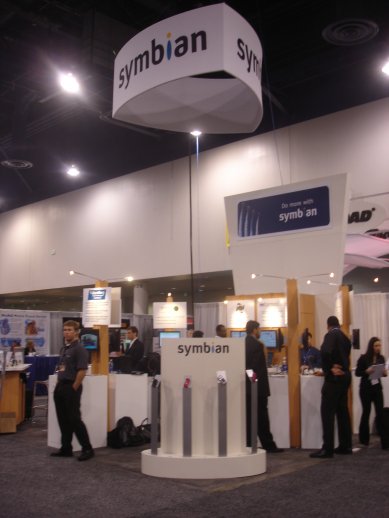 Symbian's Simon Garth gave the keynote and discussed some of the advantages and opportunities Symbian brings to the Enterprise market. Sessions included an analyst round table with representatives from InStat, Canalys, Strategy Analytics, Gartner and the Yankee group. The panel members introduced a mix of data, some of which was contradictory. One analyst commented that Windows Mobile and Palm were the likely key future players in the smartphone space, even allowing for the fact this comment covered only the US market, it was something of a sweeping generalisation. By contrast Canalys representative highlighted the differences between the US and European markets, and commented that Nokia was gearing up for a big enterprise play with it's Eseries devices. A major problem for the future was the inability to explain the potential of smartphones to users. The analysts agreed there was something of a problem in the sales channel with the explanation of device capabilities. Furthermore many users agreed they would pay more for certain features, but did not realise these features were already available in their existing smartphones. User education remains a fundamental issue for the smartphone industry.
Symbian's Simon Garth gave the keynote and discussed some of the advantages and opportunities Symbian brings to the Enterprise market. Sessions included an analyst round table with representatives from InStat, Canalys, Strategy Analytics, Gartner and the Yankee group. The panel members introduced a mix of data, some of which was contradictory. One analyst commented that Windows Mobile and Palm were the likely key future players in the smartphone space, even allowing for the fact this comment covered only the US market, it was something of a sweeping generalisation. By contrast Canalys representative highlighted the differences between the US and European markets, and commented that Nokia was gearing up for a big enterprise play with it's Eseries devices. A major problem for the future was the inability to explain the potential of smartphones to users. The analysts agreed there was something of a problem in the sales channel with the explanation of device capabilities. Furthermore many users agreed they would pay more for certain features, but did not realise these features were already available in their existing smartphones. User education remains a fundamental issue for the smartphone industry.
Other sessions included discussion of application and services for enterprise users. DataViz were on hand to discuss their RoadSync product. During their presentation they revealed plans to make both RoadSync and Documents to Go available on S60 3rd Edition shortly. The discussion of mobile email and device security dominated much of the summit, with a conclusion that there was still much potential to be fulfilled. At the summit Bluefire Security Technologies was announcing support for the Symbian OS (http://www.bluefiresecurity.com/Symbian_Support.htm). Bluefire have an impressive pedigree in the security field and offer a highly flexible and robust security suite and VPN solution. Bluefire foresee a need for the securing of VOIP communication and has position themselves accordingly.
One of the most interesting sessions was titled 'the future of the smartphone', in which Symbian's David Wood and UIQ's CEO Johan Sandberg participated. Also present was HTC Americas Todd Achilles. While the session was more about the differing strategies of the various companies and the near future than the far future it did provide some interesting insights. Johan talked about UIQ's vision of looking at future trends and enabling them through the UI. UIQ sees a trend towards device and UI differentiation for specific market groups and believe UIQ is ideally placed to serve this market. The introduction of various Sony Ericsson UIQ phones (general, messaging and music) give a great deal of weight to this argument. Johan also argued that, as a platform, UIQ offered considerable savings in costs of ownership. David Wood highlighted the importance of Symbian's open platform approach arguing that an open platform allows users to get the features they want even if its not build it the original platform. He used the example of the video recording functionality being added to the first smartphones. David highlighted Symbian's dominant market position and the prospects for continuing growth and the resultant experience learnt from this position. In response to the moderator query about the relevance of Mobile Linux he argued that the common conception that the 'OS doesn't matter' was wrong, arguing that the Symbian OS is considerably superior to any of it's competitors. In particular he pointed towards the performance advantages of Symbian OS, the complexity of telephony integration, and most importantly of all the ability to work with the operators. HTC's Todd Achilles agreed about the importance of an open platform and explained HTC's advantage, from a device manufacturer viewpoint, was experience and cost savings, he argued that device cost was very important saying that user spending more to buy converged devices must be able to justify that cost.
In a response to a question the panel discussed the challenges of security versus openness which sometimes appear to be in conflict. The panel agreed that the security issue is largely driven by operators setting certain requirements for devices with security being of paramount concern. The panel agreed that security constraints were generally desirable because they allowed the market to grow into higher volumes, although a careful balance must be struck. David Wood pointed out that there was a focus on adding applications at the end user stage (which is most impacted by security and signing issues), but that many of the advantages of an open platform were to be found not at the end user level, but at the device manufacturer and operator levels where platforms allow standardisation. He pointed to the success of Symbian in the Japanese market as an example of this. DoCoMo has achieved considerable cost savings by using Symbian OS with it's own UI but the devices themselves are locked down when delivered to the end user. Johan Sandberg and David Wood pointed towards certification and accreditation programs such as Symbian Signed as key in insuring confidence at all levels of the value chain and allowing the advantages of openness to flourish. Users and Operators can be assured of its authenticity and developers get a better channel to market for commercial products. Todd pointed that although roughly 80% of user experience and functionality could be built into a platform or a device it was very often the final 20% that made the difference in selling devices.
Finally the panel discussed the importance of user experience. There was a general agreement that this is an increasingly important area where much potential exist for improvement. The panel members thought that increasing adaptive user experience was likely to play a prominent role. The importance of device customisation and differentiation is that it goes part way to this device adaptability. David Wood concluded by saying that Symbian, on contrast to its competitors, does not impose rules on how devices should look or operate. Instead there is a healthy competition with several difference UIs. Johan and David reminded the audience that this ethos continued into the UIs themselves where device customisation was a key part of both the UIQ and S60 offering.
With Symbian as Platinum sponsors and Nokia as Gold sponsors the Smartphone Summit was one of the few areas at CTIA where the Symbian OS, S60 and UIQ had a significant presence. For those attending the summit a broad picture of the smartphone scene was provided. Even so some of the speakers lacked a global perspective, while clearly the Treo is a key device in the US market, calling it the 'most advanced and best selling smartphone' is somewhat inaccurate.
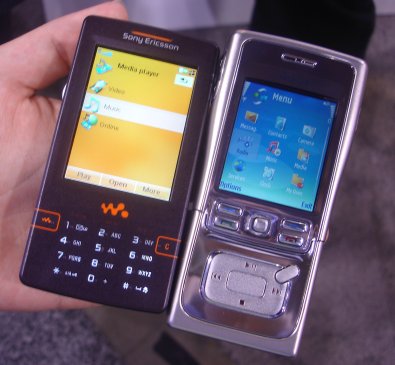
The CTIA Tradeshow
CTIA Keynotes
As with all the big conference the keynotes dominated the first half of each day. Keynotes ranged from the launch of Disney Mobile (you think you've seen it all until Mickey Mouse, in person, launches an MVNO), to a fascinating look at mobile telecoms in Afghanistan from the CEO of Roshan. Masao Nakamura President and Chief Executive Officer of NTT DoCoMo summarised his company's plan for the future with a vision of the mobile phone as a lifestyle device controlling and interacting with the world around. The mobile would be used for payment and identification services - everything from opening the front door to picking up virtual prescriptions from the chemist. DoCoMo are implementing this through Felicia technology which I am sure we will be hearing more about in the future. Jorma Ollia, Nokia's outgoing CEO, used one of his last public speeches to reflect on some of the changes in the mobile industry in the last 10 years and to lay down a marker about the importance of emerging markets. Jeff Jordan of PayPal used his keynote to formally launch PayPal Mobile which bring PayPal payments to the mobile arena. With a global reach and established user base PayPal Mobile is one to watch.
The Show Floor
The Show Floor at CTIA is large with hundred of companies from all parts of the mobile economy exhibiting. The main hall was dominated, as usual, by the manufacturers stand which were showcasing all the latest devices. CTIA is rather sedate compared to some European trade shows. Despite being in Las Vegas, where you can't walk more than 10 metres without being offering exotic entertainment, the stands were devoid of entertainment (no loud music, no booth babes or blokes) instead earnest speakers would assault your ears from all directions with news about the latest exciting service from XYZ Widgets. There is one universal constant at mobile trade shows - just as at 3GSM there weren't many women around outside the PR representatives - the mobile industry seems to be dominated by men whichever market you are in.
Nokia
Nokia was showing off all of it's recently announced device at one of the biggest booths on the show floor. At CTIA Nokia announced a number of CDMA devices (Series 40 feature phones) including the Nokia 6126 and 6175i shown below which were receiving a lot of attention. There was no sign of the long predicted S60 CDMA phone, and Nokia commented that it CDMA alliance with Sanyo was concentrated of low and mid tier devices. It seems now that an S60 CDMA device is most likely only going to happen if there is operator demand.
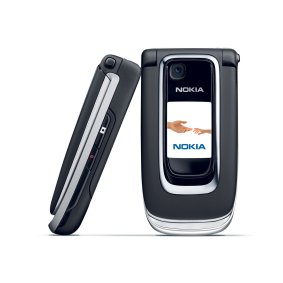
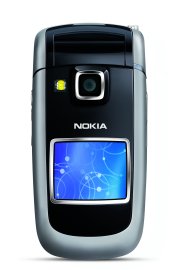
Nokia was showing off the new Eseries and Nseries devices and they were attracting a lot of attention. The N71 in particular seemed to generate some positive comments, which probably says more about the US love of clamshell devices than anything else. The everything but the kitchen sink N80 was also popular, I was reminded how light and small this device is, especially when compared to it's Nseries sister the N91. The S60 Platform presence, outside the devices themselves, was limited to two of twenty-five or so pods scattered around the Nokia booth. The S60 team are going to have to better than that in the future if they want to build mind share in the US.
There were numerous small demos on the various pods around the booth. One was the Mix and Burn kiosk demo which was showing a music buying kiosk connected to a Nokia N91. The idea is that a user chooses a selection of tracks from multiple albums and artists to create a customised play list. This can then be loaded straight on to the N91 via a USB connection. There is a large range of music to choose from. The listing is fairly comprehensive and using the touchscreen interface it is possible to quickly choose a large amount of music to load on to your device. Although there were no details about when this functional would be available, the person demoing the concept said all it really required was an extra connector (mini-USB) to be added the production booths to allow the N91 to be fully supported. The kiosks have already had a limited roll out (using CDs as the output rather than an N91).
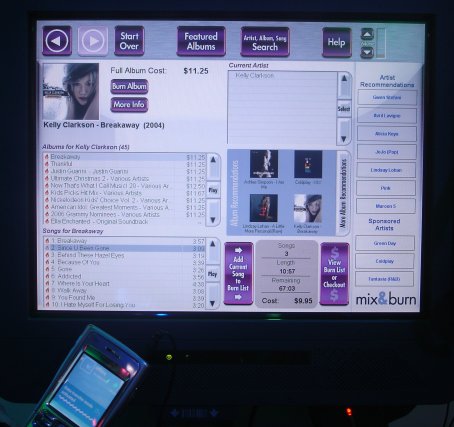
Napster was also providing a music demo running on a Nokia 6682. The demo was a mobile version of the Napster website allowing you to log in to your account, browse music, look at the community features such as recommendation and view information about music in the Napster catalog. Tracks could be bought via the website where they would be automatically added to your account so the next time you connected via PC the purchased track would be automatically downloaded. Napster also plan to make downloading track to mobile a feature of the service, which in the US, will initially be provided through operator portals. Napster believe it's name recognition means it will do significantly better than operators own branded music stores and services. I was also able to confirm that Napster plan to support the various Nokia models supporting the Windows Media DRM in it's music subscription service.
There were a number of Forum Nokia Pro developers showing off their software including Concrete Software and GoSub60 who both concentrate of Java games and distribute through operator channels. For Symbian smartphones at least, there is less use of the direct to consumer channel by developers in the US compared to Europe, instead they seem to concentrate on partnering with operators. While this has obvious benefits in some respects it does tend to limit the geographic scope of the addressable market and heavily favours Java applications over native Symbian applications. While many of the biggest ISVs in the Symbian world are US based (all three Office Suites come out of the US), there seem to be a smaller number, proportionally, of the smaller sized development companies.
Nokia also showed the assembled press a live demo of UMA technology. There is not much to see, but nonetheless it is impressive to see a call being handed overt from GSM to WiFi and back again. UMA looks set to be a very important technology in the coming years.
Sony Ericsson
Sony Ericsson were showing off their W950 UIQ music phone together with a range of accessories, including various types of speakers and stereo Bluetooth headsets. The P990 and M600 were also be loudly shown off at the front of the stand, with the M600 seeming to generate a particular amount of interest among the Blackberry wielding crowd.
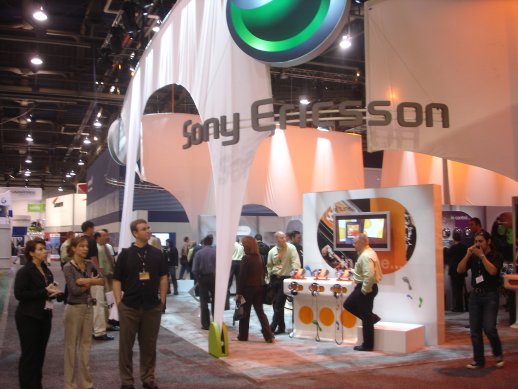
Symbian
Symbian had a modest stand in the second hall which was being shared by a number of their enterprise focused partners as well as UIQ Technology and the S60 Platform. The UIQ Developer team were on hand to explain the benefits of the UIQ platform and the UIQ Developer Program. EMCC were demoing some of the solution they have developed for others, they remain one of the leading Symbian focused development consultancies. IBM was demonstrating Symbian OS phones using IBM WebSphereEveryplace which allows secure access to enterprise resources. Visto and RIM were demoing their respective mobile email offerings, barely 5 metres apart.
Other Big Names
Motorola and Samsung also had large stands. Neither of them were displaying any of their Symbian OS devices that I could see. The Motorola M1000 did have pride of place in the NTT DoCoMo stand, sadly the rest of the world will never see the A1010, Motorola have confirmed there are no plans to ship this phone anywhere. Motorola announced a new version of the RZR adding a memory card slot and announcing various new colours. Among people I spoke to there was a feeling that Motorola might be living on borrowed time. Motorola currently seem to be style driven and the consensus was that could only last so long. That together with a far from ideal UI, and a delayed an thin smartphone line up means the future might not be so rosy as the present. However for the time being there no doubting Motorola short term success. The RZR, SLVR and PBL have been very successful and are instantly recognisable.
Bluetooth Accessories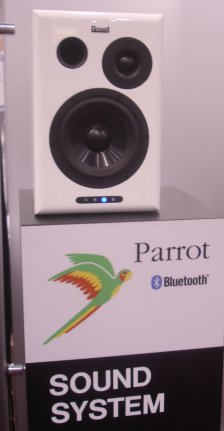 The major Bluetooth accessory vendors were also much in evidence. Parrot was showing of it's new headsets but also had two products, which although initially for niche markets may become more popular over time. The first was the Image Frame which accepts image files via Bluetooth and will then display them in a digital photo frame. These have been available before, but Parrot have added a few nice touches such as automatic image resize on receipt by the frame optimising the storage space available. Second was a set of Bluetooth speakers - these are HiFi style speakers. They include line in for standard audio connection, but also include a Bluetooth module supporting A2DP meaning you can stream stereo audio over Bluetooth to the speakers. Both of these products will be available later in the year, and you can expect them to set you back around 200 and 450 Euros respectively.
The major Bluetooth accessory vendors were also much in evidence. Parrot was showing of it's new headsets but also had two products, which although initially for niche markets may become more popular over time. The first was the Image Frame which accepts image files via Bluetooth and will then display them in a digital photo frame. These have been available before, but Parrot have added a few nice touches such as automatic image resize on receipt by the frame optimising the storage space available. Second was a set of Bluetooth speakers - these are HiFi style speakers. They include line in for standard audio connection, but also include a Bluetooth module supporting A2DP meaning you can stream stereo audio over Bluetooth to the speakers. Both of these products will be available later in the year, and you can expect them to set you back around 200 and 450 Euros respectively.
Jabra was showing off a range of headsets including their new A2DP Stereo Bluetooth headset. The Jabra BT 620s were among the most comfortable stereo headset I've tried and produced excellent audio output.
eMoze Push E-mail
Emblaze launched their eMoze Push Email system at the show. The VP of Marketing, Doron Cohen, said that he saw eMoze as the Skype of push e-mail. The vision is to bring push e-mail within reach of everyone. The eMoze system works by installing a PC connector on your desktop and leaving it running while you go mobile. For those who have no wish to leave their PC running or take it with them this presents something of a problem. However Doron was keen to stress that Emblaze were aware of this issue and planned to roll out features that allow for push email to continue even if there was no PC Connector online. The system should work with any POP mail box. There are also plans in place to role out the service to as many handset as possible, as well as increase the range of supported PC PIM clients and PC operating systems. eMoze will be platform and device agnostic, although emphasis will be given to those devices, such as S60 phones, which are on the market in large numbers. The eMoze service will be available for free in its basic form, premium paid services (such as file transfer) will be added in due course, and companies wishing to buy an eMoze enabled email server will be able to do so. eMoze is backed by the resources of the Emblaze group, which has substantial experience and IP in this area. Doron commented that the legal framework had been carefully examined and eMoze should avoid any of the legal complications that have befallen other vendors in this area. eMoze is definitely one to watch and we will be covering them in more detail in due course.
4Smartphone.net
An alterative to the push email espoused by eMoze is to use Microsoft Exchange which now has built in push email. However for the individual setting up an Exchange server is almost impossible, and would be very costly. Enter 4smartphone.net which aims to provide individuals and small business' with Exchange accounts. 4smartphone.net doesn't expect you to change your email address - instead you forward your existing email to your Exchange account (POP box collection is also available). 4smartphone.net gives you a full Exchange account with Web and Mobile access to your email, schedule and tasks for a small monthly fee. Nokia's Eseries phones support Exchange out of the box and no additional software will be required, for other phones third party software such as DataViz's RoadSync will enable your phone for an Exchange account.
Action Engine
Action Engine were demoing an interesting twist on the concept of mobile content in partnership with MSNBC. Rather than charging users for content they were making it available fore free, but were inserting advertising into the content (both text and video). Action Engine are already well known for their expertise in mobile usability and are looking to broaden their reach into mobilising content. The advertising subsidised content model does seem to work well - Action Engine have worked hard to make sure it is not too intrusive, but I am yet to be convinced by the wide scale viability of such a content model.
Opera
Opera were showing off their mobile browser both on various platform and in its J2ME guise. Opera Mini has an impressive 2 million users (4 million page views a day). Opera have what I think is one of the smartest business plans in the mobile space for Opera Mini. They intend to give it away for nothing to users, but make money from searches performed using Opera Mini and from licensing agreements with other brands. Opera have already announced several of these, and more were announced at CTIA. Opera were also demoing the Opera Platform, which is easily the best mobile browser platform available. The demo they were showing (currently being trailed with 100 users in Oslo) combines on phone caching and with AJAX functionality to minimise network round trips. It mixes in phone functionality, information and services with web based services (such as maps) to create a very impressive user experience. Some of the features demoed include maps integrated with train and bus times for your current bus stop and location aware yellow pages.
Route Finding and GPS Navigation
All the major Route Finding / GPS Navigation software providers were present at CTIA. All of them expect to support Symbian OS 9.1 handsets shortly, although none were able to offer a specific date. Route 66 were showing off their new version, much improved over their previous offering and announced coverage for the Americas at CTIA. Wayfinder have also recently launched a new version recently which further extends their lead in the over the air navigation (off board) space.
Sling Media
Sling Media, who offer a set top box which allow you to watch your home TV anywhere in the world via an Internet connection were showing off their first mobile client. The current version is for Windows Mobile and although Brian Jaquet, their PR Director, would not be drawn on specifics he did say that Sling are looking very closely at other mobile platforms. Sling are looking to launch in Europe shortly and Symbian support would seem to be a necessary part of any plans for mobile service in Europe. Sling will face stiff competition from ROK Mobile who will be launching their own mobile enabled set top box service in time for the World Cup and Orb who existing free service includes support for mobiles in remotely viewing your home PC's media content.
Apple and Mobile
With all the talks of MVNO's thanks to Disney Mobile, Helio and others it was inevitable that speculation among attendees would turn to Apple. A few commentator seemed to have expect Apple to announce it's intentions in the mobile area at CTIA, but it was not to be. Many people think it is a foregone conclusion that Apple will shortly launch a MVNO and an accompanying iPhone. What form the iPhone will take was the source of much speculation. Many seem to think Apple would blow the market away. The basis of this is that Apple have done such a marvelous job in the MP3 player market they are bound to the same in the mobile space. Moreover Apple know as well as anyone that the stand alone MP3 market will gradually shrink away over the next 5 years.
However common sense with regard to Apple seemed in short supply, with many underestimating the difficulties in developing mobile phones. Apple may have excellent engineers, but they have little experience in the mobile space. While at first feature phone device similar to the Motorola ROKR phone may be sufficient in order to compete effectively long term a mobile OS platform would seem to be essential. In due course Apple competition will increasingly be the high end converged devices such as the Nokia N91, Nokia N80, Sony Ericsson W950 and the Windows Mobile offerings from Samsung and HTC. Which direction Apple will take remains to be seen, and their success if by no means certain, contrary to what many people might tell you.
The US is another market
CTIA Wireless is one the biggest mobile trade shows and conferences in the world. It is dominated by the US market and as a result CTIA is unashamedly all about the Americas and it provides a valuable insight into the US market for the uninitiated. In the past a contrast has been drawn between the US market and the rest of the world with the US usually regarded as being backward cousin. That is not really true now - in wireless broadband, certain data and multimedia service the US market is right at the cutting edge, but there is still a huge contrast between the US and the European markets. This is partly a result of market differences, but it is also due to cultural difference in usage patterns. If you think the operators have a stranglehold in Europe, it is nothing compared to the US.
The contrast between the enterprise and consumer markets is much more pronounced. There is very little smartphone / open platform device usage in the consumer market. While some entertainment services are well developed thanks to high speed networks, ultimately they are very much tied to individual carriers and therefore often lack the 'openness' and extensibility more prevalent in Europe and which may be necessary for mass market adoption of such services.
The idea of device convergence which seems to have been championed by the smartphone in Europe is far less prevalent in the US. Even within the enterprise sector, where open platform devices are more prevalent, mobiles are often considered extra devices (people will also carry a PDA or a laptop) and are dominated by the need to mobilise email, with a resulting emphasis on thumb board based input devices (such as the Treo or Blackberry ranges). This means where open platform devices are being used they tend to stop being phones and morph into PDAphones. The smartphone in the traditional phone form factor (be it flip or candy bar) is a rare beast. Whereas 3 of the top 8 handsets in Europe were S60 smartphones in Q4 2005, in the US the top 10 was filled with phones that would be characterised as mid range feature phones in Europe. A good illustration of this is the comparison between device lineups on the Verizon Wireless (http://www.verizonwireless.com/) and Orange UK websites (http://www.orange.co.uk/).
From the Symbian ecosystems viewpoint the US market serves as a reminder that the Symbian OS is not predominant everywhere. The difference between the 90% market share in Europe versus the 20% market share in the US is clearly visible. Despite this there are a lot of companies working on products that run on one of the Symbian platforms that are US based although they universally wish for more S60, Series 80 and UIQ presence in the US market. However there are companies that are unaware of the number of devices in Europe, with a response of there 'not being enough devices for us to consider developing for the platform' a not uncommon response.
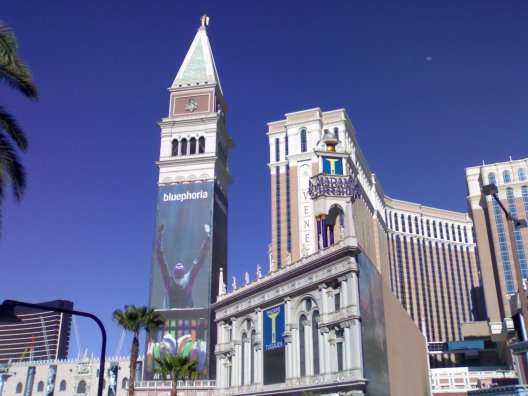
As a result CTIA is something of a contrast to 3GSM which although generally European dominated has a more international feel. There's discussion and companies from outside the European market, and the event seems to take the pulse of the global mobile ecosystem.
At 3GSM it seemed that every other stand was demoing a program or service running on a smartphone (and 90% on these S60 or UIQ phones), and the talk was around how open platforms were finally beginning to deliver on their promise and the benefits that would bring the mobile economy. Vodafone's S60 announcement, Sony Ericsson portfolio of UIQ devices, and the predictions of 250 million smartphones by 2008 stand out as examples of this. In many cases companies were using smartphones as test devices and did plan to launch on to feature phones, but the general feeling was that smartphones allowed for easier development (even when developing in Java), more innovative products, and that market platformisation was just a matter of time.
Symbian OS was the clear market leader with universal awareness. Indeed Symbian and it's UIs were no longer very exciting or buzz worthy, but rather had become incumbents and part of the mobile landscape, almost something of a universal constant. Symbian position was regarded as strong although not unassailable, with the competitive buzz around Mobile Linux and (in the enterprise space) Windows Mobile.
By contrast at CTIA smartphone demos were rare outside the Nokia, Sony Ericsson and Symbian booths. Microsoft and Palm had a strong showing, and demos using the Windows Mobile and Palm were not uncommon although in nothing like the numbers seen at 3GSM.
Of course this introductory comment is a very sweeping generalisation, but the general impression given is of a market that does not see the full potential of the open mobile platform in the mass market. Currently there is a limit to what can be achieved because of the capabilities of the devices and the stranglehold of the carriers on the mobile experience. The open mobile platform is, of course, not the promised land, but it does remove many of the road blocks for growth and answer many of the questions which I think the US market may face in the next few years surrounding issues such as the costs of developing, supporting and using advanced devices, together with the creation of an ecosystem of services and products (carrier independent) which allows device specialisation and differentiation, which is and will drive mobile growth in other markets.
The US market does seem to have a better developed awareness of mobile content and is further along in many respects in this area than the European market. A lot of the major brands are looking very closely at mobile, as is typified by Disney's move into the mobile space. Disney launched as an MVNO (mobile virtual network operator) at CTIA. But other Internet brands such as AOL, Yahoo and Google have also been moving into the space. There is a limit to what can be done on ordinary phones (largely browser based, especially outside the carriers influence) and the most innovative services and content branding were running on smartphone such as MSNBC's content service (powered by an Action Engine smartphone client).
So the conclusion? The US is another market. And Vegas? It's an interesting place!

